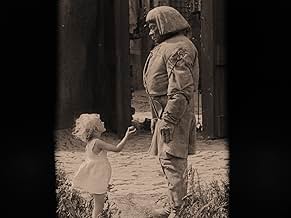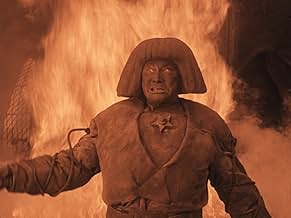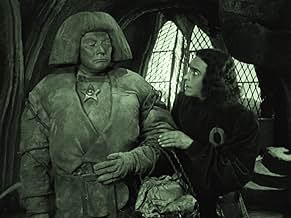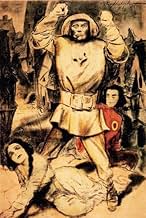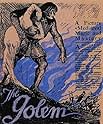IMDb RATING
7.2/10
9.1K
YOUR RATING
In 16th-century Prague, a rabbi creates the Golem - a giant creature made of clay. Using sorcery, he brings the creature to life in order to protect the Jews of Prague from persecution.In 16th-century Prague, a rabbi creates the Golem - a giant creature made of clay. Using sorcery, he brings the creature to life in order to protect the Jews of Prague from persecution.In 16th-century Prague, a rabbi creates the Golem - a giant creature made of clay. Using sorcery, he brings the creature to life in order to protect the Jews of Prague from persecution.
- Directors
- Writers
- Stars
- Awards
- 1 win & 1 nomination total
Hans Stürm
- Der Rabbi Jehuda, der Älteste der Gemeinde
- (as Hans Sturm)
Carl Ebert
- Temple Servant
- (uncredited)
Fritz Feld
- Jester
- (uncredited)
Loni Nest
- Ein kleines Mädchen
- (uncredited)
- …
Ursula Nest
- Little Girl
- (uncredited)
Dore Paetzold
- Des Kaisers Kebse
- (uncredited)
- …
Märte Rassow
- Kind
- (uncredited)
- Directors
- Writers
- All cast & crew
- Production, box office & more at IMDbPro
Featured reviews
I caught this restored version of the 1920 German silent classic at Lincoln Center where a new musical score was premiered by the Chamber Music Society. I had never seen the film before and was frankly amazed at the imagery in the sets and costumes and editing of the film. The film's director, Paul Wegener, wearing a thickly padded outfit and wig and high-heeled boots plays the main character, "The Golem". A mythical character from Jewish folklore. For its day, the special effects were also intriguing. I resist describing the movie as anti-semitic but I believe that the portrayal of the jewish ghetto was depicted so dramatically to show that the jews in Prague were outsiders and not welcome in mainstream society. This is evident in the fact that when a nobleman comes to the ghetto, he is greeted by a mammoth closed gate that looks like a precursor to the one used in King-Kong. And most notably, during the creation sequence, a satanic figure appears on screen that would coincide with the European belief a that time that Jews walk hand-in-hand with the Dark forces.
As far as the Golem's performance- this film is really a precursor to "Frankenstein" that Boris Karloff must have seen in its original release - there are so many similarites.
Biggest Image - at the conclusion, the Golem is surrounded by a group of "blond" Aryan-looking children that clearly distinguish them from the ghetto children that we see earlier in the film.
As far as the Golem's performance- this film is really a precursor to "Frankenstein" that Boris Karloff must have seen in its original release - there are so many similarites.
Biggest Image - at the conclusion, the Golem is surrounded by a group of "blond" Aryan-looking children that clearly distinguish them from the ghetto children that we see earlier in the film.
This landmark film is one of the earliest surviving expressionist works, and it's art direction and photography-- while not as stunning as a film like Caligari-- is still extremely interesting with its misshapen sets and its use of light and shadow, and light within shadow. Unlike Caligari, the themes of this film were resonant long after its release, and perhaps still are today.
The Golem is a tolerance film that studies in depth the relationship between Jews and Christians in Prague. To his credit, Wegener refuses to impose stereotypes on either party, instead concentrating on individual characters and using mass characterizations only to highlight the themes of the film.
Unlike stereotypical Jews, rich guys with big noses who rub pennies together, the Jews of Prague are decidedly poor. It is interesting to note that the Jews are all dressed in black and with very few exceptions appear to be bent with age, a tribute to an aging and dying religion. However, they are also portrayed to be earnest and hard-working, with strong communal instincts. The Christians, by contrast, appear bright, shiny, and new. They are dressed in light colors and are young and wealthy, and outwardly appear to be God's new chosen. However, they are also portrayed as foolish bohemians who do not take God seriously. In the end, Christian innocents (and blonde-blue Aryan, coincidentally)are able to stop the Golem's rampage, but only because he allows it. The final shot shows the Star of David lying in the dust as the Jews come to carry their fallen champion back into the ghetto, closing the great door behind them and leaving you with a feeling that they are gone forever. However, it should be noted that the Golem is not only a champion to the Jews, but a symbol of revival.
Another interesting comparison in this film is that between the Golem and Jesus. Like man, the Golem is made of sand and clay, then given life by a supernatural force. They are both immaculate conceptions, with the Golem being motherless while Jesus is born to a virgin mother. Jesus in his time was a champion of the Jews, as is the Golem, and each of them rebelled against the wickedness of the authorities that governed them.
This open-ended presentation of the struggle of Christianity vs. Judaism is what makes this film truly great. I suspect that this relevant elevation above the ordinary is the reason for its survival, even though it is the third film of this series. The fact that Wegener was able to make a film that is so ambiguous is a credit to him considering the circumstances surrounding German film-making at the time.
Rabbi Loew is portrayed as a wise and heroic leader of the Jewish community, which lives in a winding ghetto. He creates the Golem for a noble cause-- to protect his people against eviction by the Christians--and in this cause succeeds after the Christian court is saved by the Golem from divine repudiation after laughing at Loew's presentation of the Old Testament. The creation scene is particularly interesting, not only in its visuals, but for the fact that in this scene Rabbi Loew wears white (for purity), yet performs a ceremony that is holy in nature yet seems like witchcraft. The Golem turns on him when he seeks to continue using the Golem's services for selfish purposes after the Golem has accomplished his mission.
Miriam and Loew's servant are portrayed quite differently. Miriam is a dark seductress who is unwittingly the cause of the Golem's destructive rampage. She is only saved from the hands of the Golem by another act of divine intervention, when the communal prayer of the Jews in the streets of the ghetto results in her release. She usually dresses in dark colors. However, there is also a scene before her affair with Florian in which she wears white (purity of a different kind). Also notice how Florian carelessly twirls a flower when he delivers the edict to Rabbi Loew. This is a brief, but effective, example of his character and foreshadows things to come. Loew's servant is the only other young Jewish character in the film besides a few Jewish children in the street, and it is his revival of the Golem during his jealous rage against Florian that sets the Golem on his destructive path. Like Loew, he is unable to remove the Star of David from the Golem's chest once he begins to use the Golem for selfish gain. In the end, he shares a poignant moment with Miriam where they seek forgiveness and confidence about their actions.
The depth and attention to detail that Wegener shows as a director (and writer) in this film helps to place it among the great films in the brief history of cinema. It's message is particularly haunting considering the events of the next 25 years after its release.
The Golem is a tolerance film that studies in depth the relationship between Jews and Christians in Prague. To his credit, Wegener refuses to impose stereotypes on either party, instead concentrating on individual characters and using mass characterizations only to highlight the themes of the film.
Unlike stereotypical Jews, rich guys with big noses who rub pennies together, the Jews of Prague are decidedly poor. It is interesting to note that the Jews are all dressed in black and with very few exceptions appear to be bent with age, a tribute to an aging and dying religion. However, they are also portrayed to be earnest and hard-working, with strong communal instincts. The Christians, by contrast, appear bright, shiny, and new. They are dressed in light colors and are young and wealthy, and outwardly appear to be God's new chosen. However, they are also portrayed as foolish bohemians who do not take God seriously. In the end, Christian innocents (and blonde-blue Aryan, coincidentally)are able to stop the Golem's rampage, but only because he allows it. The final shot shows the Star of David lying in the dust as the Jews come to carry their fallen champion back into the ghetto, closing the great door behind them and leaving you with a feeling that they are gone forever. However, it should be noted that the Golem is not only a champion to the Jews, but a symbol of revival.
Another interesting comparison in this film is that between the Golem and Jesus. Like man, the Golem is made of sand and clay, then given life by a supernatural force. They are both immaculate conceptions, with the Golem being motherless while Jesus is born to a virgin mother. Jesus in his time was a champion of the Jews, as is the Golem, and each of them rebelled against the wickedness of the authorities that governed them.
This open-ended presentation of the struggle of Christianity vs. Judaism is what makes this film truly great. I suspect that this relevant elevation above the ordinary is the reason for its survival, even though it is the third film of this series. The fact that Wegener was able to make a film that is so ambiguous is a credit to him considering the circumstances surrounding German film-making at the time.
Rabbi Loew is portrayed as a wise and heroic leader of the Jewish community, which lives in a winding ghetto. He creates the Golem for a noble cause-- to protect his people against eviction by the Christians--and in this cause succeeds after the Christian court is saved by the Golem from divine repudiation after laughing at Loew's presentation of the Old Testament. The creation scene is particularly interesting, not only in its visuals, but for the fact that in this scene Rabbi Loew wears white (for purity), yet performs a ceremony that is holy in nature yet seems like witchcraft. The Golem turns on him when he seeks to continue using the Golem's services for selfish purposes after the Golem has accomplished his mission.
Miriam and Loew's servant are portrayed quite differently. Miriam is a dark seductress who is unwittingly the cause of the Golem's destructive rampage. She is only saved from the hands of the Golem by another act of divine intervention, when the communal prayer of the Jews in the streets of the ghetto results in her release. She usually dresses in dark colors. However, there is also a scene before her affair with Florian in which she wears white (purity of a different kind). Also notice how Florian carelessly twirls a flower when he delivers the edict to Rabbi Loew. This is a brief, but effective, example of his character and foreshadows things to come. Loew's servant is the only other young Jewish character in the film besides a few Jewish children in the street, and it is his revival of the Golem during his jealous rage against Florian that sets the Golem on his destructive path. Like Loew, he is unable to remove the Star of David from the Golem's chest once he begins to use the Golem for selfish gain. In the end, he shares a poignant moment with Miriam where they seek forgiveness and confidence about their actions.
The depth and attention to detail that Wegener shows as a director (and writer) in this film helps to place it among the great films in the brief history of cinema. It's message is particularly haunting considering the events of the next 25 years after its release.
The giant frame of Paul Wegener as the Golem is one of the best known characters from the silent era, and one of the first icons of horror. Der Golem is actually the third film to feature the character, the first being The Golem (1915), and the second The Golem And The Dancing Girl (1917), which is a short comedy with Wegener donning the costume to frighten a girl he is in love with. Tragically, those two films are now considered lost, and only fragments equalling about 14 minutes of the first film remain. This film is actually a prequel, and it's full title is Der Golem: Wie Er In Die Welt Kam (How He Came Into The World), but is now commonly know as simply Der Golem.
The Jews of medieval Prague face persecution from the townsfolk. Terrified of their doomed fate, Rabbi Loew (Albert Steinruck) uses his skills in black magic to create The Golem, a mythical figure from Jewish folklore. He is made entirely from clay, and has an amulet in his chest that gives him power, and when removed turns him back into lifeless clay. He is initially used as a servant, and then to terrify the townsfolk who are threatening them. The Golem eventually gets tired of being used as a tool of fear and begins to turn on his creator, and starts to lay waste to the Ghetto.
Like the majority of films made in Weimar Germany, the film has an expressionist tone, with lavish, artistic sets that dominate the frame. Similar in feel to the great Das Cabinet Des Dr. Caligari, it is however more subtle in its artistic flair, and lacks Caligari's rickety (although wonderful in its own way) sets. It is also quite terrifying in its realisation of a segregation that would occur in the country only a decade later, although it does portray the Jews as vengeful and as studying the dark arts.
The Golem itself is a great movie monster. Tragic in the same way as Frankenstein's monster, he is brought into the world without having asked to be, and is expected to carry out terrible acts against his will. Paul Wagener portrays him with all silent intensity and uncontrollable rage, with his towering frame sending his enemies running for the hills. He also impressively co-wrote and co-directed the film. This is an enjoyable film that breezes by in its rather slight running time, and can be forgiven for some over-acting and the occasional tedious scene. It also has some interesting social comments, and is a frightening prelude to one of the most horrific periods in Europe's history.
www.the-wrath-of-blog.blogspot.com
The Jews of medieval Prague face persecution from the townsfolk. Terrified of their doomed fate, Rabbi Loew (Albert Steinruck) uses his skills in black magic to create The Golem, a mythical figure from Jewish folklore. He is made entirely from clay, and has an amulet in his chest that gives him power, and when removed turns him back into lifeless clay. He is initially used as a servant, and then to terrify the townsfolk who are threatening them. The Golem eventually gets tired of being used as a tool of fear and begins to turn on his creator, and starts to lay waste to the Ghetto.
Like the majority of films made in Weimar Germany, the film has an expressionist tone, with lavish, artistic sets that dominate the frame. Similar in feel to the great Das Cabinet Des Dr. Caligari, it is however more subtle in its artistic flair, and lacks Caligari's rickety (although wonderful in its own way) sets. It is also quite terrifying in its realisation of a segregation that would occur in the country only a decade later, although it does portray the Jews as vengeful and as studying the dark arts.
The Golem itself is a great movie monster. Tragic in the same way as Frankenstein's monster, he is brought into the world without having asked to be, and is expected to carry out terrible acts against his will. Paul Wagener portrays him with all silent intensity and uncontrollable rage, with his towering frame sending his enemies running for the hills. He also impressively co-wrote and co-directed the film. This is an enjoyable film that breezes by in its rather slight running time, and can be forgiven for some over-acting and the occasional tedious scene. It also has some interesting social comments, and is a frightening prelude to one of the most horrific periods in Europe's history.
www.the-wrath-of-blog.blogspot.com
Imagine shooting a feature-length horror movie with the camera built into your mobile phone. Now imagine disabling sound and colour on your phonecam, only being able to shoot a few seconds at a time, each minute costing a small fortune in recording material, imagine that phonecam being large and unwieldy and kind of knackered so that the already low-resolution image is flickery and erratically exposed, and it plays back too fast so that people look like wound-up dolls. It also exposes blueish light more than reddish light, so each shoot is unpredictable, but of course you'll only know that the next day when the film has been processed.
Welcome to movie-making in the year 1920 AD.
Now go shoot a masterpiece that will still be watched, talked about and revered in a hundred years.
I watched this out of historic interest and expected to be colossally bored. But far from it, this is actually a gripping horror flick, and one with a deep side to it to boot. The Golem himself is an immensely scary horror figure en par with Freddy Kruger or the Alien, kind of a proto-Frankenstein's monster -- and he's actually played by director Paul Wegener himself!. I'd like to know how they made his eyes so scary.
Anyway, what can I say, a stupendous film. Watch it from the edge of your seat.
Welcome to movie-making in the year 1920 AD.
Now go shoot a masterpiece that will still be watched, talked about and revered in a hundred years.
I watched this out of historic interest and expected to be colossally bored. But far from it, this is actually a gripping horror flick, and one with a deep side to it to boot. The Golem himself is an immensely scary horror figure en par with Freddy Kruger or the Alien, kind of a proto-Frankenstein's monster -- and he's actually played by director Paul Wegener himself!. I'd like to know how they made his eyes so scary.
Anyway, what can I say, a stupendous film. Watch it from the edge of your seat.
"Der Golem" is surely one of the best German expressionist silent movies. It may be second only to "The Cabinet of Doctor Caligari"; I enjoyed it as much as Murnau's "Faust", and, truth be told, more than "Nosferatu".
You probably already know the story: it's a well-known Jewish folk tale about a rabbi who constructs a stone creature (a golem) to protect his fellows from an anti-Semitic government in medieval Prague. The creature impresses the gentiles, but then it turns on its master.
These movies aren't really about plot, nor characters. They're about mood, setting, and mise-en-scene. The golem itself is an indelible image; surprisingly it was played by the writer-director himself, who must have been a massive person. You can see the influence on James Whale's classic "Frankenstein". The settings are also sumptuous and fitting.
My mind did wander, but not as much as when I watched Swedish silent "Korkarlen", also a horror film based on local myth. I appreciated that the story was easy to follow and interesting.
You probably already know the story: it's a well-known Jewish folk tale about a rabbi who constructs a stone creature (a golem) to protect his fellows from an anti-Semitic government in medieval Prague. The creature impresses the gentiles, but then it turns on its master.
These movies aren't really about plot, nor characters. They're about mood, setting, and mise-en-scene. The golem itself is an indelible image; surprisingly it was played by the writer-director himself, who must have been a massive person. You can see the influence on James Whale's classic "Frankenstein". The settings are also sumptuous and fitting.
My mind did wander, but not as much as when I watched Swedish silent "Korkarlen", also a horror film based on local myth. I appreciated that the story was easy to follow and interesting.
Did you know
- Trivia"Aemaet", the life-giving word which Rabbi Lowe compels from the spirit Astaroth is also reflected in the bolts of lightning at the end of the creation scene.
- GoofsThe story is set in the 16th Century. A prediction of doom is made based on the movements of Uranus, which was not discovered until 1781.
- Alternate versionsThe 2002 Alpha Video DVD version runs for 101 minutes. This is not evident from the back of the Alpha Video DVD case, which wrongly lists the running time as only 85 minutes. It looks as if Alpha Video somehow got hold of the fullest version currently known - maybe even a complete version of the film, since there are no obvious gaps in the story.
- ConnectionsEdited into People Who Die Mysteriously in Their Sleep (2004)
- How long is The Golem?Powered by Alexa
Details
- Runtime1 hour 16 minutes
- Color
- Sound mix
- Aspect ratio
- 1.33 : 1
Contribute to this page
Suggest an edit or add missing content



